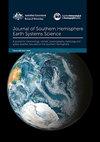循环触发器指数:量化修正稳定性的预测方向
IF 3.6
4区 地球科学
Q1 Earth and Planetary Sciences
引用次数: 0
摘要
“翻翻指数”旨在量化预报从一个发布时间到下一个发布时间的变化程度,现已扩展为“循环翻翻指数”,用于预报风向、涌浪方向或类似情况。设计这个指数是为了让我们了解风向预报的稳定程度。循环翻转指数独立于观测结果,定义相对简单,只要预测保持在180°扇区内,就不会对显示趋势的一系列预测进行处罚。循环触发器指数是根据预测变化对预测使用者决策的影响来解释的。循环触发器指数被用来比较自动预报指导序列和澳大利亚气象局官方预报序列的稳定性,后者是手工准备的。这是对方向预测稳定性的第一个客观评价。结果表明,自动预报指南的风向预报比官方的人工预报更稳定,这本身就是许多数值天气模式的共识。循环触发器指数不衡量技能,但可以在描述和评估预测系统方面发挥补充作用。本文章由计算机程序翻译,如有差异,请以英文原文为准。
Circular Flip-Flop Index: quantifying revision stability of forecasts of direction
The Flip-Flop Index, designed to quantify the extent to which a forecast changes from one issue time to the next, is extended to a Circular Flip-Flop Index for use with forecasts of wind direction, swell direction or similar. The index was devised so we could understand the degree of stability in wind direction forecasts. The Circular Flip Flop Index is independent of observations, has a relatively simple definition and does not penalise a sequence of forecasts that show a trend as long as the forecasts stay within a 180° sector. The Circular Flip-Flop Index is interpreted in terms of the impact of changing forecasts on decisions made by users of the forecast. The Circular Flip-Flop Index has been used to compare the stability of sequences of automated forecast guidance to the official Australian Bureau of Meteorology forecasts, which are prepared manually. It is the first objective assessment of the stability of forecasts of direction. The results show that the forecasts of wind direction from the automated forecast guidance, itself a consensus of many numerical weather models, are more stable than the official, manual forecasts. The Circular Flip-Flop Index does not measure skill but can play a complementary role in characterising and evaluating a forecasting system.
求助全文
通过发布文献求助,成功后即可免费获取论文全文。
去求助
来源期刊

Journal of Southern Hemisphere Earth Systems Science
Earth and Planetary Sciences-Oceanography
CiteScore
8.10
自引率
8.30%
发文量
0
审稿时长
>12 weeks
期刊介绍:
The Journal of Southern Hemisphere Earth Systems Science (JSHESS) publishes broad areas of research with a distinct emphasis on the Southern Hemisphere. The scope of the Journal encompasses the study of the mean state, variability and change of the atmosphere, oceans, and land surface, including the cryosphere, from hemispheric to regional scales.
general circulation of the atmosphere and oceans,
climate change and variability ,
climate impacts,
climate modelling ,
past change in the climate system including palaeoclimate variability,
atmospheric dynamics,
synoptic meteorology,
mesoscale meteorology and severe weather,
tropical meteorology,
observation systems,
remote sensing of atmospheric, oceanic and land surface processes,
weather, climate and ocean prediction,
atmospheric and oceanic composition and chemistry,
physical oceanography,
air‐sea interactions,
coastal zone processes,
hydrology,
cryosphere‐atmosphere interactions,
land surface‐atmosphere interactions,
space weather, including impacts and mitigation on technology,
ionospheric, magnetospheric, auroral and space physics,
data assimilation applied to the above subject areas .
Authors are encouraged to contact the Editor for specific advice on whether the subject matter of a proposed submission is appropriate for the Journal of Southern Hemisphere Earth Systems Science.
 求助内容:
求助内容: 应助结果提醒方式:
应助结果提醒方式:


